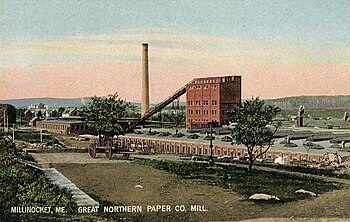Great Northern Paper Company
 | |
 Great Northern Paper Company mill in Millinocket, Maine, 1907 | |
| Formerly | Northern Development Company |
|---|---|
| Company type | Private |
| Industry | Pulp and Paper Mill |
| Founded | 1897 in Millinocket, Penobscot County, Maine, USA |
| Founders | Charles W. Mullen and Garret Schenck |
| Defunct | August 2014 |
Area served | Many US States |
| Products | Paper |
Great Northern Paper Company was a Maine-based pulp and paper manufacturer that at its peak in the 1970s and 1980s operated mills in Arkansas, Georgia, Maine, and Wisconsin and produced 16.4% of the newsprint made in the United States.[1]
The company was acquired by Georgia-Pacific Corporation in 1990. Its name was revived in 2011 when private equity firm Cate Street Capital acquired Great Northern's original Maine mills.
History
Maine


The company got its start when the Maine legislature authorized Charles W. Mullen to form a water power company on the West Branch Penobscot River. Mullen had observed the 110-foot (34 m) drop of the West Branch Penobscot River at Grand Falls in 1891 while surveying a route for the Bangor and Aroostook Railroad.[2] He later worked with Garret Schenck, part owner of the Rumford Falls Paper Company, to build a paper mill in Millinocket, Penobscot County, Maine on the river. Schenck formed the Northern Development Company in 1897.
The Millinocket plant produced its first roll of newsprint on 9 November 1900.[2] A second mill in Madison opened in 1906. A third one opened in East Millinocket in 1907, which also had its own dam and hydroelectric facility.[3] Financiers of the corporation included Oliver Payne and William Collins Whitney.[4]
When the Millinocket Mill opened it was the world's largest paper mill, producing 240 tons/day of newsprint, 120 tons/day of sulfite pulp, and 240 tons/day of ground wood pulp.[5][6] It was the first paper mill to have an electrical generation and distribution facility built into the plant. The company's innovations included a pulpwood grinding machine still known throughout the paper industry as Great Northern grinders.[2]
In the 1910s Great Northern built the Ripogenus Dam and powerplant on the West Branch Penobscot River. Construction of a thermal power plant in 1958 raised the total generating capacity of the Millinocket mill complex to 200,000 horsepower (150,000 kW). High-pressure steam generated by burning waste bark was routed first through generator turbines, and the low-pressure exhaust steam was then used to dry the paper. Mid-20th-century paper production of 1,000 tonnes per day was sold to 250 newspapers east of the Mississippi River.[2]
In 1930 the company sold 6,000 acres (24 km2) around Maine's highest point Mount Katahdin for $25,000 to former Maine Governor Percival Proctor Baxter. In turn Baxter donated the land to the state, for what became the present day Baxter State Park.
In the 1940s its timber holdings increased to more than 2 million acres and its work force was supplemented during World War II by a prisoner of war camp at Seboomook Farm near Moosehead Lake.[3]
20th century mergers and acquisitions
In 1962 the Great Northern Paper Company expanded to Jakin, Georgia, where it formed a subsidiary named the Great Southern Land and Paper Company. It produced corrugated linerboard.[3]
In 1970 the Great Northern Paper Company merged with the Nekoosa-Edwards Paper Company in Nekoosa, Wisconsin and was renamed the Great Northern Nekoosa Corporation.[3]
In 1971 the company completed construction of the 97 mile Golden Road in Maine, that paralleled the West Branch Penobscot River from Quebec to its mill at Millinocket. It ended the practice of floating logs down the river via log driving, and instead shipping them by truck.[3]
In 1989 Georgia-Pacific launched a hostile takeover of the company which closed in 1990 for $3.8 billion.[7] Georgia-Pacific in turn sold the Maine holdings to Bowater of South Carolina in 1991.[3]
In 1999 Inexcon, a Canadian company, acquired the Maine holdings.
21st century
The Inexcon holdings in Maine went into bankruptcy in 2002. They were acquired by Brascan Corporation in April 2003 and operated under the name of Katahdin Paper Company LLC. In 2003 Brookfield Asset Management bought the mills after the company filed for bankruptcy.[8] That company continued its decline, laying off workers in 2008.[3]
In 2011 the Kathadin Paper Company LLC holdings in Maine were acquired by Cate Street Capital of Portsmouth, New Hampshire. They revived the Great Northern Paper name.[9] The mill at East Millinocket was launched again although with diminished output. The purchase by Cate Street was seen as a positive alternative to the closing of the mill at a time when the region was experiencing 22% unemployment.[8]
The Millinocket mill was never reopened, but for a while it seemed that the East Millinocket mill could improve its financial status. Within the year of the Cate Street purchase and the reopening of the East Millinocket mill over 250 people had been hired.[8]
Just one year later the mill was called upon to supply the paper needed to produce the popular trilogy "Fifty Shades of Grey." The mill's output that year was 3,000 tons of paper, mostly for the three-part novel, which was printed on Great Northern's Baxter Brite paper.[8]
In 2013 Cate Street Capital announced plans to tear down virtually all the mill buildings at the Millinocket plant, and replace them with structures to operate a Torrefaction wood operation, under the name of its subsidiary Thermogen Industries.[10]
In 2014 the over 100-year-old paper mill was forced to close down its operations. Originally the company and workers were hopeful that the closure would be temporary.[11] However, when the company sent out notices under the WARN Act (Workers Adjustment and Retraining Notification Act) to its workers in August, 2014,[12] the closure could only be understood as permanent.[8] At the time of the bankruptcy Great Northern listed over 1,000 creditors in its filing.[13]
An investigation done by the Maine Sunday Telegram uncovered that a majority of the $40 million investment in the Great Northern Paper mill was "returned the same day to investors." The investors are receiving $16 million from Maine's General Fund over seven years. The research showed that neither the $31.8 million loan nor the $8.2 million equity investment was used to pay for improvements to the mill.[13]
On January 12, 2017, Our Katahdin, a 501(c)3 non-profit organization based in the Katahdin region, purchased all remaining former Great Northern Paper Company assets in Millinocket through the sale of two subsidiaries of Cate Street Capital, GNP West and GNP Holding II.[14]
See also
References
- ^ "Great Northern Nekoosa Corporation - Lehman Brothers Collection". Library.hbs.edu. Retrieved 2013-08-06.
- ^ a b c d Strout, W. Jerome (1966). 75 Years The Bangor and Aroostook. Bangor, Maine: Bangor and Aroostook Railroad. pp. 39&40.
- ^ a b c d e f g "Fogler Library: Finding Guide to the Great Northern Paper Company Records". Library.umaine.edu. Retrieved 2013-08-06.
- ^ "Birth of the Paper Giant | Great Northern Paper". Greatnorthernpaperhistory.com. Retrieved 2013-08-06.
- ^ "Town Manager". Millinocket.org. Retrieved 2013-08-06.
- ^ "History of Papermaking: Maine Pulp and Paper Association". Pulpandpaper.org. Archived from the original on 2013-10-24. Retrieved 2013-08-06.
{{cite web}}: Unknown parameter|deadurl=ignored (|url-status=suggested) (help) - ^ https://www.nytimes.com/1990/09/28/business/company-news-georgia-pacific-in-asset-sale.html
- ^ a b c d e Gleason, Stephanie (23 September 2014). "Shuttered Great Northern Paper to Liquidate in Bankruptcy". The Wall Street Journal. Retrieved 27 April 2015.
- ^ "Great Northern Paper". Greatnorthernpaperhistory.com. Retrieved 2013-08-06.
- ^ Sambides, Nick (2013-02-23). "Millinocket Great Northern Paper buildings to be torn down to make way for industrial park — Business — Bangor Daily News — BDN Maine". Bangordailynews.com. Retrieved 2013-08-06.
- ^ Sambides, Jr., Nick (6 February 2014). "East Millinocket paper mill announces layoffs affecting 212 workers". The Bangor Daily News. Retrieved 27 April 2015.
- ^ Sambides Jr., Nick (8 August 2014). "Great Northern issues closure warning notices to East Millinocket millworkers". The Bangor Daily News. Retrieved 27 April 2015.
- ^ a b Fishell, Darren (20 April 2015). "Report: None of $40 million taxpayer-assisted investment improved Great Northern mill". The Bangor Daily News. Retrieved 27 April 2015.
- ^ "Mill Site Acquisition". Our Katahdin. Retrieved 2017-01-16.
External links
- Pulp and paper companies of the United States
- Papermaking in the United States
- Companies based in Penobscot County, Maine
- Defunct companies based in Maine
- Georgia-Pacific
- Millinocket, Maine
- North Maine Woods
- Manufacturing companies established in 1897
- Manufacturing companies disestablished in 2014
- 1897 establishments in Maine
- 2014 disestablishments in Maine
- Defunct pulp and paper companies
